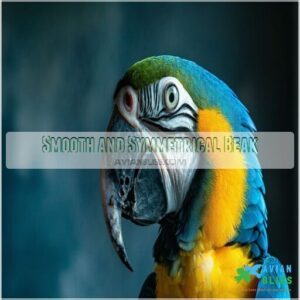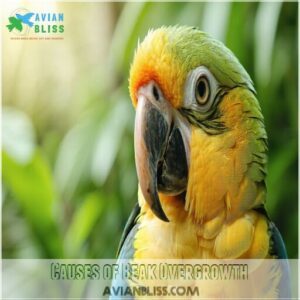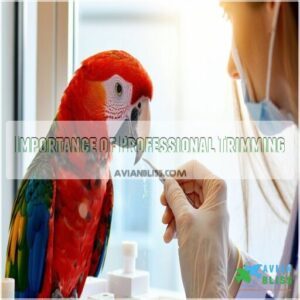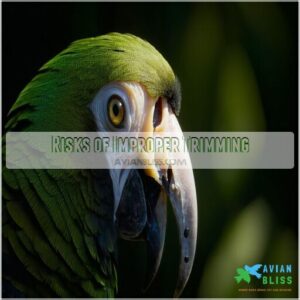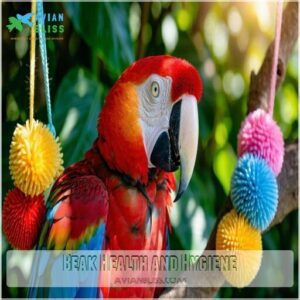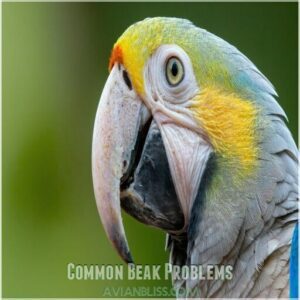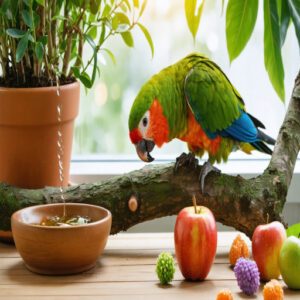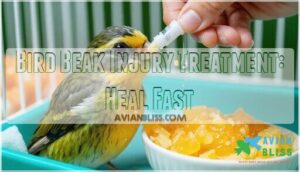This site is supported by our readers. We may earn a commission, at no cost to you, if you purchase through links.
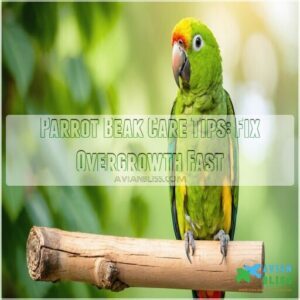 You’re looking for parrot beak care tips, right? To keep your parrot’s beak healthy, provide chew toys, hard foods, and plenty of opportunities for natural wear.
You’re looking for parrot beak care tips, right? To keep your parrot’s beak healthy, provide chew toys, hard foods, and plenty of opportunities for natural wear.
A balanced diet is also important. Regularly inspect your parrot’s beak for signs of overgrowth or discoloration.
Remember, a healthy beak is smooth and symmetrical. By following these parrot beak care tips, you’ll be well on your way to preventing beak problems – and there’s more to learn about keeping your feathered friend’s beak in top shape.
Table Of Contents
- Key Takeaways
- Healthy Beak Characteristics
- Causes of Beak Overgrowth
- Preventing Beak Overgrowth
- Beak Trimming and Care
- Beak Health and Hygiene
- Common Beak Problems
- Maintaining Beak Health
- Frequently Asked Questions (FAQs)
- How do parrots keep their beaks healthy?
- How do you keep a bird’s beak healthy?
- How do you prevent beak overgrowth in a parrot?
- Can parrots have overgrown beaks?
- How do you remove a parrot’s beak?
- How do you care for a parrot?
- How do I keep my parrot’s beak healthy?
- How do you take care of a parrot’s beak plant?
- Do I need to trim my parrot’s beak?
- How to treat a parrot beak?
- Conclusion
Key Takeaways
- You’ll want to provide your parrot with plenty of chew toys and hard foods to keep their beak healthy and prevent overgrowth.
- It’s crucial to inspect your parrot’s beak regularly for signs of overgrowth, discoloration, or other issues, and to take action if you notice any beak problems.
- You should prioritize a balanced diet and regular veterinary check-ups to support your parrot’s overall health and prevent beak problems.
- Don’t try to trim your parrot’s beak yourself – instead, consult a vet for professional trimming and advice on how to keep your parrot’s beak healthy and strong.
Healthy Beak Characteristics
You want to make sure your parrot’s beak is healthy, and that means it should be smooth, symmetrical, and the right size.
By checking your parrot’s beak regularly, you can catch any potential issues early on, and help keep their beak in great shape.
Smooth and Symmetrical Beak
Checking your parrot’s beak shape and symmetry is essential.
A healthy beak is smooth and symmetrical, key to parrot beak care and overall health, ensuring proper beak anatomy and alignment.
Essential for parrot beak trimming and shaping, and important beak care tips for a healthy, happy parrot.
Proper Beak Alignment
You’ll often notice a properly aligned beak has upper and lower parts that fit together seamlessly, ensuring beak symmetry and jaw alignment.
This alignment is essential for parrot beak care, as alignment issues can lead to parrot beak problems.
Affecting overall parrot beak health is a critical consideration, as these issues can have significant consequences.
Beak Color and Texture
You check your parrot’s beak color and texture, looking for Beak Pigmentation issues or Color Changes, which can signal Fungal Infections or other parrot beak problems, affecting parrot beak health and anatomy.
So monitor for Beak Discoloration and unusual Texture Analysis to preserve a healthy parrot beak.
Changes in beak color can indicate underlying health problems in canaries as well, which is a key aspect of parrot beak health.
Causes of Beak Overgrowth
You’re probably wondering what causes your parrot’s beak to overgrow, and it’s often due to improper diet, insufficient beak use, or infections.
By understanding these causes, you can take steps to prevent overgrowth and keep your parrot’s beak healthy, so let’s take a closer look at what might be going on with your feathered friend.
Improper Diet and Nutrition
You can prevent beak overgrowth by feeding a balanced parrot diet.
Avian vets recommend preventing budgie beak overgrowth through proper diet.
Here are some tips to ensure proper parrot nutrition:
- Pellets
- Fresh veggies
- Fruits
- Nuts
- Seeds, to avoid Malnutrition Effects and beak health issues.
Insufficient Beak Use
You’re likely causing beak problems if your parrot’s beak is underused, so provide beak exercise through gnawing needs, chew options, and beak stimulation, promoting jaw movement, a key part of parrot beak care tips to prevent beak problems.
A healthy, balanced diet, including essential parrot beak health, is essential for preventing beak problems, and is a crucial aspect of overall parrot beak care.
Infections and Injuries
You worry about beak infections, right?
- Beak Infections
- Bacterial Damage
- Fungal Diseases
- Beak Trauma, all can cause overgrowth, so monitor your parrot’s beak, and get help if you notice any issues, like parrot beak infection symptoms, to prevent parrot beak overgrowth.
Preventing Beak Overgrowth
You can prevent beak overgrowth by providing your parrot with plenty of chew toys, and hard foods to keep them busy.
By doing so, you’re helping your parrot wear down their beak naturally, and reducing the risk of overgrowth, which can lead to some serious health issues.
Providing Chew Toys
You can help your parrot’s beak by giving them chew toys, like wooden blocks, to shape their beak naturally.
A wide variety of parrot chew toys are available for purchase.
Rotate toys often to keep them interested in chewing, which helps maintain their beak health with natural chewing on parrot beak toys and parrot chew toys.
Offering Hard Foods
You’re already giving your parrot chew toys, now offer hard seeds, nutritious pellets, and fresh fruits to promote beak health, making parrot beak care easier.
Supporting parrot beak maintenance with crunchy vegetables and chewable treats is essential for best beak health.
Encouraging Natural Beak Wear
You encourage natural beak wear by providing chew toys, natural abrasives, and gnawing materials.
This helps with beak grinding, shaping, and trimming, making parrot beak care easier, promoting healthy beak wear and maintenance.
Supporting natural debris extraction, all key to preventing overgrowth, is crucial for the overall health of the parrot.
Beak Trimming and Care
You’re taking a big step by learning about beak trimming and care, which is important for your parrot’s health and happiness.
By understanding the importance of professional trimming, you’ll be able to keep your parrot’s beak healthy and strong, and prevent problems like overgrowth.
Importance of Professional Trimming
So, you’ve worked hard to prevent overgrowth, but sometimes a trim is needed.
Don’t grab your clippers just yet! Parrot beak trimming is best left to trained professionals.
Why?
- It’s tricky, like giving a haircut to a squirmy worm.
- Special beak shaping tools are needed. Think tiny, bird-safe sanders.
- An avian veterinarian offers expert advice and veterinary guidance. Plus, they’ve the right trimming tools. Safe beak trimming is key!
Parrot owners should understand beak trimming considerations to make informed decisions about their pet’s care.
Risks of Improper Trimming
You risk beak damage, trimming errors, and nerve exposure with improper trimming, leading to beak infection and pain, so prioritize beak trimming safety tips to avoid parrot beak injury and beak problems, using correct beak trimming tools.
For severe injuries, consider beak injury treatment options.
| Error | Cause | Effect |
|---|---|---|
| Nerve Exposure | Improper Trimming | Pain |
| Beak Infection | Trimming Errors | Beak Problems |
| Beak Damage | Incorrect Tools | Parrot Beak Injury |
The key to preventing these issues is to understand the potential parrot beak injury and take steps to mitigate them, ensuring the health and well-being of your parrot by using the right tools and techniques for beak trimming.
Beak Filing and Shaping
You’ll use filing tools for beak smoothing, and shaping to restore your parrot’s beak.
A parrot beak file product can assist in this process.
Beak shaping and polishing are part of parrot beak care, similar to nail care, and beak trimming or parrot beak clipping, which helps prevent overgrowth, ensuring a healthy, happy beak.
Beak Health and Hygiene
You’re taking a big step in keeping your parrot’s beak healthy by learning about beak health and hygiene.
By following some simple tips, like using textured perches and providing natural beak cleaning opportunities, you can help prevent overgrowth and keep your parrot’s beak in great shape.
Natural Beak Cleaning
You’re helping your parrot with beak trimming, now let’s talk about natural beak cleaning.
Beak wiping on natural branches, textured perches, or soft surfaces helps, and fibrous fruits gently scrub beaks, making parrot beak cleaning a breeze with the right tools, like a beak cleaning kit.
Textured Perches and Surfaces
You’re giving your parrot a comfy home with textured perches, right?
Choose perch materials with a rough surface texture, like natural branches or abrasive blocks, to promote beak grinding, a key part of parrot beak care and hygiene.
Parrot owners can purchase parrot textured perches online to keep those parrot perches clean and tidy.
Regular Beak Inspection
You inspect your parrot’s beak daily, checking for symptoms like discoloration or overgrowth.
Use inspection tools for a thorough beak examination, monitoring beak health and anatomy to catch issues early.
Making daily checks a habit is crucial for ideal parrot beak condition and overall well-being.
Common Beak Problems
You’re likely familiar with some common beak problems, like overgrowth, discoloration, and peeling, which can be pretty frustrating for you and your parrot.
As you care for your parrot, recognizing these issues early on is vital, so you can take action to prevent or fix them, and keep your feathered friend happy and healthy.
Overgrown Beak Issues
You’re dealing with overgrown beak issues, a common problem in parrots.
Beak malformation can lead to beak surgery, so prevent overgrowth with regular trimming, and consider beak repair or reshaping if needed, as part of parrot beak care to avoid beak problems.
Discoloration and Peeling
What’s causing discoloration and peeling on your parrot’s beak?
Beak stains, fungal infections, or color changes can be culprits.
Peeling causes concern, so check for beak lesions, and prioritize parrot beak hygiene to prevent beak health issues and abnormalities, addressing beak problems for a healthy parrot beak condition.
Beak Trauma and Injuries
You’ll want to prevent beak trauma, which can be painful, by avoiding collisions, providing a safe space, and being gentle.
Beak fractures, bleeding, or damage require emergency care, so know what to do in case of a parrot beak injury to make sure proper beak repair and treatment.
Maintaining Beak Health
You’re taking the first step to maintaining your parrot’s beak health, which is great!
By following some simple tips, like providing a balanced diet and regular veterinary check-ups, you can help prevent beak overgrowth and keep your parrot happy and healthy.
Balanced Diet and Nutrition
You feed your parrot a balanced diet with nutrient balance, food variety, and pellet supplements.
Add fresh produce like fruits and vegetables for a healthy parrot beak diet, ensuring good beak health through proper bird nutrition, including calcium sources.
Creating balanced avian diet plans supports optimum health, which is a key factor in a healthy parrot’s life, and following a balanced diet is crucial.
Regular Veterinary Check-ups
Regular check-ups with an avian veterinarian are key for your feathered friend. Think of it as a spa day for their beak!
- Beak Exam: Your avian vet will give your parrot’s beak a thorough examination, checking for any health issues. 2. Health Checks: They’ll also do a general health check-up, because sometimes beak problems can be related to other things.
- Vet Visit Tips: Bring a list of any questions or concerns you have. This is your chance to tap into their avian expertise! 4. Preventive Care: Your avian veterinarian can offer preventive care tips, like advice on diet and beak trimming, to keep your parrot’s beak in tip-top shape.
Providing Enriching Environment
You’re doing great on those vet visits, now let’s talk environment.
Provide toys and chews, a fun cage setup, and social interaction to keep your parrot happy and stimulated.
With natural perches and textured surfaces for parrot enrichment, it’s a win-win for their beak health and overall well-being.
Frequently Asked Questions (FAQs)
How do parrots keep their beaks healthy?
You help parrots keep beaks healthy by providing chew toys, varied diets, and regular veterinary check-ups to prevent overgrowth and maintain strong, sharp beaks.
How do you keep a bird’s beak healthy?
You keep a bird’s beak healthy by providing a balanced diet, offering chew toys, and ensuring access to fresh water, all of which help maintain beak shape and overall health.
How do you prevent beak overgrowth in a parrot?
You prevent beak overgrowth in parrots by providing chew toys, varied diets, and regular veterinary check-ups to guarantee their beaks stay healthy and trimmed naturally.
Can parrots have overgrown beaks?
You can spot overgrown beaks in parrots, which are often caused by poor diet, infection, or injury, so monitor your parrot’s beak health regularly for any signs of overgrowth.
How do you remove a parrot’s beak?
You shouldn’t remove a parrot’s beak, instead, consult a vet for trimming or filing to prevent damage and promote healthy beak growth, ensuring your parrot’s overall well-being and safety always.
How do you care for a parrot?
You care for a parrot by providing a balanced diet, fresh water, and a clean environment, while also offering toys and social interaction to keep them happy and healthy always.
How do I keep my parrot’s beak healthy?
You keep your parrot’s beak healthy by providing a balanced diet, offering chew toys, and scheduling regular veterinary check-ups to prevent overgrowth and maintain overall beak health and function.
How do you take care of a parrot’s beak plant?
You’ll want to water, prune, and give your parrot’s beak plant plenty of sunlight to keep it happy and thriving, just like your feathered friend.
Do I need to trim my parrot’s beak?
Notably, 80% of parrots need beak trims, so you’ll likely need to trim your parrot’s beak regularly, but consult a vet first.
How to treat a parrot beak?
You’ll need to consult a vet, who can trim or remove your parrot’s beak, and address any underlying health issues causing the problem, to guarantee your parrot’s beak health.
Conclusion
You’re basically a beak expert now, so don’t let your parrot’s beak get out of control.
Follow these parrot beak care tips, and you’ll be fixing overgrowth in no time.
Remember, a healthy beak is key, so keep an eye on it, and provide plenty of chew toys, and your parrot will thank you, with a perfectly shaped beak, using these simple parrot beak care tips.
- https://kniselys.com/blog/64135/parrot-beak-care-101
- https://amerikanki.com/pets/tips-for-caring-for-parrot/
- https://www.birdexoticsvet.com/how-to-care-for-a-parrot
- https://www.birdcagesnow.com/blogs/bird-blog/how-to-prevent-overgrown-beaks-in-pet-parrots
- https://parrotjunkie.com/health/parrot-beak-health-conditions/

